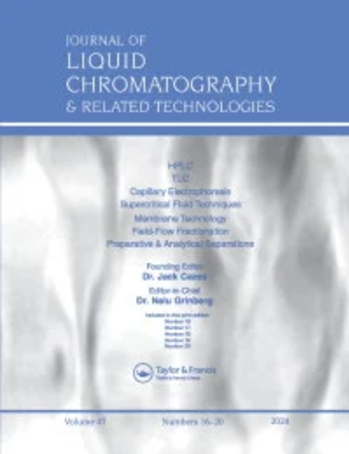API吡喹酮主要降解产物的质谱表征:稳定性指示反相UPLC方法的开发和验证
IF 1.2
4区 化学
Q4 BIOCHEMICAL RESEARCH METHODS
Journal of Liquid Chromatography & Related Technologies
Pub Date : 2022-07-21
DOI:10.1080/10826076.2022.2163253
引用次数: 1
摘要
摘要根据国际协调会议指南Q1A(R2)的规定,在水解(酸性、碱性和中性/水)、氧化、光解和热的各种条件下对吡喹酮进行了强制降解研究。针对API,开发了一种简单快捷的反相超高压可编程控制器方法。该方法是在Shimadzu,Shimpack Velox,SP-C18100上开发的 × 2.1 毫米,1.8 µm柱。等度流动相是水和乙腈的混合物,其比例分别为70:30(v/v)。流动相的流速为0.5 毫升/分钟。使用ICH指南对所开发的方法进行了验证。方法验证所考虑的参数包括溶液稳定性、特异性、DL/QL、线性、准确度、精密度和稳健性。该药物在酸性和碱性条件下表现出显著降解,而在水和氧化条件下观察到轻微降解。该药物被发现在光解和热条件下是稳定的。四种主要降解产物(DP1、DP2、DP3和DP4)的表征采用LC–Q-TOF-MS/MS结合准确的质量测量进行。根据碎片模式提出了最可能的DP形成机制。图形摘要本文章由计算机程序翻译,如有差异,请以英文原文为准。
Characterization of the major degradation products of the praziquantel API by mass spectrometry: Development and validation of a stability-indicating reversed phase UPLC method
Abstract Praziquantel was subjected to forced degradation studies under various conditions of hydrolysis (acidic, alkaline, and neutral/water), oxidation, photolysis, and thermal as prescribed by International Conference on Harmonization guideline Q1A (R2). A short and simple reversed phase UHPLC method was developed for the Praziquantel API. The method was developed on a Shimadzu, Shimpack Velox, SP-C18, 100 × 2.1 mm, 1.8 µm column. The isocratic mobile phase was a blend of water and acetonitrile in the ratio of 70:30 (v/v), respectively. The flow rate of the mobile phase was 0.5 mL/min. The developed method was validated using ICH guidelines. The parameters considered for method validation were solution stability, specificity, DL/QL, linearity, accuracy, precision, and robustness. The drug showed significant degradation in acidic and alkaline conditions while slight degradation was observed in water and oxidative conditions. The drug was found to be stable in photolytic and thermal conditions. The characterization of four major degradation products (DP1, DP2, DP3, and DP4) was done with LC–Q-TOF-MS/MS in combination with accurate mass measurements. The most probable mechanisms for the formation of DPs have been proposed on the basis fragmentation pattern. Graphical Abstract
求助全文
通过发布文献求助,成功后即可免费获取论文全文。
去求助
来源期刊
CiteScore
2.80
自引率
0.00%
发文量
29
审稿时长
4.9 months
期刊介绍:
The Journal of Liquid Chromatography & Related Technologies is an internationally acclaimed forum for fast publication of critical, peer reviewed manuscripts dealing with analytical, preparative and process scale liquid chromatography and all of its related technologies, including TLC, capillary electrophoresis, capillary electrochromatography, supercritical fluid chromatography and extraction, field-flow technologies, affinity, and much more. New separation methodologies are added when they are developed. Papers dealing with research and development results, as well as critical reviews of important technologies, are published in the Journal.

 求助内容:
求助内容: 应助结果提醒方式:
应助结果提醒方式:


